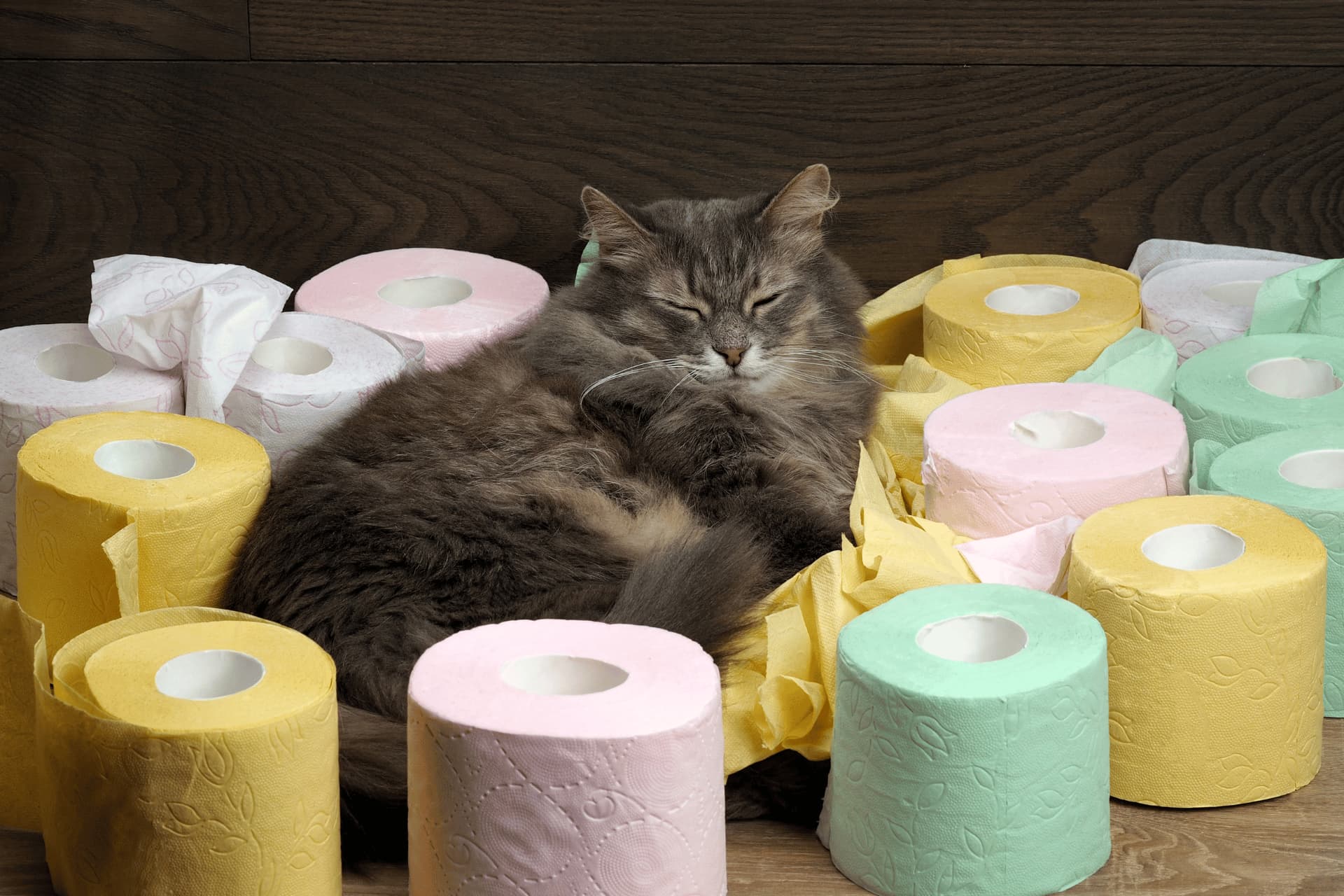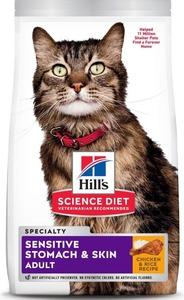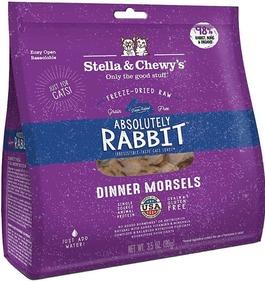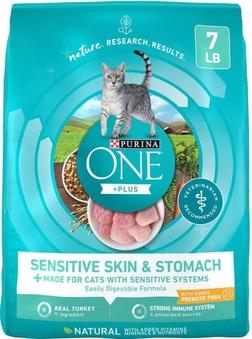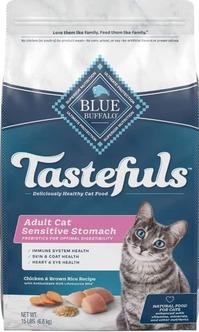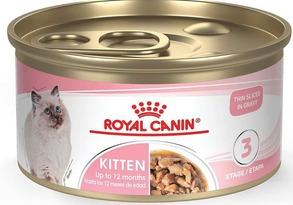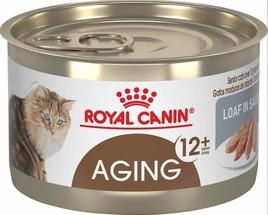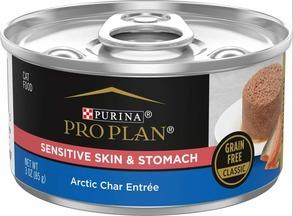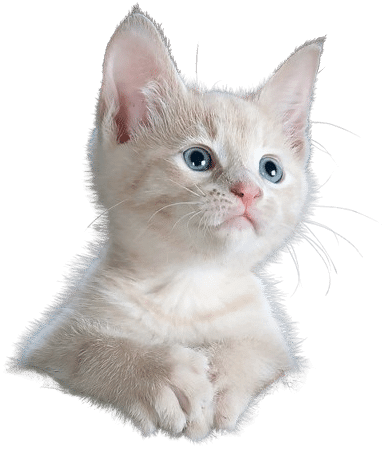I know it’s gut-wrenching to see your little furball with an upset tummy. When they aren’t feeling their best, the first thing we often question is their diet. In your search for the “best cat food for diarrhea,” you’ve come to the right place.
Over the years, I’ve found a fantastic solution that’s worked wonders for my two cats: Hill’s Science Diet Adult Sensitive Stomach & Sensitive Skin Chicken & Rice Recipe Dry Cat Food. This product has proven to be a lifesaver, soothing their stomachs and keeping their coats shiny and healthy.
Hill’s Science Diet Adult Sensitive Stomach & Sensitive Skin Chicken & Rice Recipe Dry Cat Food
Supports digestive health with prebiotic fiber
Nourishes skin and coat with vitamin E and omega-6 fatty acids
Made with natural ingredients and no artificial colors or preservatives
Reduced vomiting and hairballs
Stay tuned as we delve deeper into why this is my top pick and explore some other excellent options as well.
A Quick Comparison of Our Favorites in 2024
The Top 7 Best Cat Food For Diarrhea
Overall Best: Hill’s Science Diet Adult Sensitive Stomach & Sensitive Skin Chicken & Rice Recipe Dry Cat Food
First 5 Ingredients: Chicken, brewers rice, corn gluten meal, whole grain corn, chicken fat.
Guaranteed Protein: 29% Min
Age Range: Adult
Caloric Content: 524 kcal/cup
Food Form: Dry cat food
Best For: Cats with sensitive stomach and skin
With Hill’s Science Diet Adult Sensitive Stomach & Sensitive Skin Chicken & Rice Recipe Dry Cat Food, the key ingredients are chicken, brewers rice, corn gluten meal, whole grain corn, and chicken fat. This blend strikes a balance of lean protein, grains, and healthy fats.
Nutritionally, it packs a punch with a minimum of 29.0% crude protein and 17% crude fat. Fiber content is kept at a maximum of 3%, ensuring your pet’s digestion stays smooth. The moisture content, however, is capped at 10%. While this typically low moisture content is a concern for some cat parents, it’s a common trait in dry foods. To offset this, I often supplement Whiskers’ meals with a bit of wet food or make sure he has plenty of water available.
What sets this food apart for me and many other cat parents is its focus on sensitive stomachs and skin. The inclusion of prebiotic fiber supports gut health, reducing instances of upset tummies. My Short-haired Tabby has been notably more comfortable since switching to this food, and hairballs are now a rarity instead of a regular occurrence. In addition to digestive benefits, Hill’s Science Diet formula is enriched with Vitamin E and omega-6 fatty acids, which promote healthy skin and a shiny coat.
Based on my personal experience and the feedback from our community at TheCatParent.com, this food gets two paws up. While this dry cat food falls a bit short on moisture content, we can easily tackle this by ensuring our cats have constant access to fresh water.
What We Liked:
Supports digestive health with prebiotic fiber
Nourishes skin and coat with vitamin E and omega-6 fatty acids
Made with natural ingredients and no artificial colors or preservatives
Reduces vomiting and hairballs
What We Didn’t Like:
Low in moisture, cats will need access to water.
Main Ingredients: Rabbit with ground bone, olive oil, pumpkin seed
Guaranteed Protein: 44% Min
Age Range: Adult
Caloric Content: 4,630 kcal/kg, 196 kcal/cup
Food Form: Freeze-dried
Best For: Picky eaters
This cat food’s main ingredients are rabbit with ground bone and olive oil. These ingredients, particularly the rabbit, offer a novel protein source that’s less likely to cause allergic reactions in cats.
Another key ingredient in Stella & Chewy’s Rabbit Dinner is pumpkin seed. This may seem like a strange addition to cat food, but pumpkin seed provides fiber that aids in healthy digestion.
With a crude protein content of at least 44%, it offers a substantial protein source for your cat. It also contains a minimum of 30% crude fat, providing the necessary fats for energy and healthy skin and coat. The crude fiber content is a maximum of 5%, aiding in digestion and preventing those pesky hairballs.
With a caloric content of 4,630 kcal/kg or 196 kcal/cup, Stella & Chewy’s Rabbit Dinner fuels our cats’ playfulness and curiosity. It’s suitable for adult cats of all sizes, so whether you’re a parent to a petite Siamese or a hefty Maine Coon (like my Whiskers), this food can cater to their needs.
This food is freeze-dried, which, believe it or not, can be a game-changer. The freeze-drying process retains the nutritional value of the ingredients while making it convenient for us cat parents. It’s also a hit with picky eaters as the process intensifies the flavor.
Numerous reviewers have reported a decrease in their cats’ diarrhea episodes after switching to this food. But as with any food, there’s always the chance that some cats may not take to it. Some picky eaters might turn their noses up at the unfamiliar rabbit flavor.
What We Liked:
High protein content from real rabbit meat
Grain-free, gluten-free, and potato-free formula
Easy to rehydrate and serve
Improved coat and skin condition
What We Didn’t Like:
Some picky cats refused to eat it
Main Ingredients: Turkey, chicken by-product meal, rice flour, corn gluten meal, soybean meal
Guaranteed Protein: 34% Min
Age Range: Adult
Caloric Content: 4,016 kcal/kg, 449 kcal/cup
Food Form: Dry
Best For: Cats with skin and coat issues
The main ingredients in this dry cat food are turkey, chicken by-product meal, rice flour, corn gluten meal, and soybean meal. Chicken by-product meal provides a rich source of protein and essential vitamins. Plus, real turkey as the first ingredient ensures a high-quality protein source that’s easy on your kitty’s stomach.
It has a minimum of 34% crude protein and 14% crude fat, ensuring your cat gets the energy it needs without overloading its system. The maximum of 4% crude fiber and 12% moisture makes it a balanced offering for adult cats of all sizes. With a caloric content of 4,016 kcal/kg and 449 kcal/cup, it provides plenty of fuel for playtime.
Designed specifically for adult cats with sensitive skin and coat issues, Purina ONE +Plus does more than just fill their bellies. The inclusion of prebiotic fiber supports a balanced gut flora, promoting healthy digestion and helping manage diarrhea. Additionally, the antioxidants contribute to overall gastrointestinal health.
There’s a wealth of positive feedback from cat parents about the reduction in diarrhea symptoms when cats switch to this food. However, this product does contain a higher carbohydrate content, thanks to rice flour and corn gluten meal.
What We Liked:
Real turkey as the first ingredient
Contains prebiotic fiber and antioxidants
Crunchy kibble helps clean teeth and gums
Reduced itching and shedding
What We Didn’t Like:
Carbohydrates content above 15%
Best Alternative: Blue Buffalo Tastefuls Sensitive Stomach Natural Adult Dry Cat Food
First 5 Ingredients: Deboned chicken, chicken meal, brown rice, oatmeal, barley
Guaranteed Protein: 32% Min
Age Range: Adult – All breed sizes
Caloric Content: 3,773 kcal/kg, 422 kcal/cup
Food Form: Dry cat food
Best For: Cats who prefer a crunchy kibble
The primary ingredients in this dry cat food are deboned chicken, chicken meal, brown rice, oatmeal, and barley. These ingredients are gentle on a cat’s stomach and less likely to cause irritation. Unlike some other brands that use artificial fillers, Blue Buffalo opts for real, recognizable ingredients.
This cat food is not only gentle on the stomach but also nutritionally balanced. The maximum 3.5% crude fiber helps regulate digestion, while the moisture content, capped at 9%, aids in hydration.
Blue Buffalo Tastefuls is a grain-free and gluten-free cat food, reducing potential allergens that might upset your cat’s stomach. This formulation decreases your cat’s risk of developing allergic reactions.
This dry cat food is also packed with probiotics, which are known to support a healthy gut microbiome. These beneficial bacteria can aid in resolving digestive issues, including diarrhea, and promote overall digestive health.
Many cat parents who’ve tried Blue Buffalo Tastefuls have reported improved stool quality and consistency in their cats. This noticeable change is a clear indication of the product’s effectiveness in addressing digestive issues.
While this cat food has a high caloric content ( 3,773 kcal/kg, 422 kcal/cup), it’s crucial to remember that portion control can help manage this. Overfeeding can lead to weight gain, so it’s key to adhere to the recommended serving sizes based on your cat’s weight.
What We Liked:
Made with real chicken and brown rice
Grain-free and gluten-free formula
Contains probiotics, vitamins, and minerals
Improved stool quality and consistency
What We Didn’t Like:
High-calorie content – exercise portion control.
First 6 Ingredients: Water sufficient for processing, Chicken, Pork Liver, Chicken Liver, Brewers Rice Flour
Guaranteed Protein: 10.5% Min
Age Range: Adult
Caloric Content: 893 kcal ME/kg; 76 kcal ME/can
Food Form: Wet cat food
Best For: Kittens with diarrhea
Let’s dive right into why this product is a game-changer for kittens with diarrhea. Firstly, the texture of this wet food is a huge plus. The thin slices in gravy are soft and easily digestible, which is ideal for kittens struggling with digestive issues. Additionally, this product delivers a palatable flavor that even the fussiest kittens find hard to resist.
With a moisture content of 80.2%, this wet kitten food plays a crucial role in keeping kittens hydrated. Plus, the inclusion of water sufficient for processing and brewer’s rice flour, both excellent sources of dietary fiber, aids digestion and can help firm up loose stools.
The product’s nutritional analysis reveals that it contains 10.5% crude protein and 2.5% crude fat, offering a significant boost to a kitten’s developing immune system. This can be an essential factor when they’re recovering from a bout of diarrhea. The highly digestible chicken and pork liver ingredients are gentle on a kitten’s sensitive digestive system.
With a caloric content of 893 kcal ME/kg, this product provides the energy your little furball needs, especially during recovery.
Yes, Royal Canin may come with a slightly higher price tag than some other brands, but here’s where we need to consider the cost-benefit analysis. For your kitten’s health and your peace of mind, it might be the solution you need.
What We Liked:
Soft texture and tasty flavor for kittens
Supports immune system with antioxidants
Provides balanced nutrition for growth and development
Highly digestible and easy to eat
What We Didn’t Like:
Premium price
First 5 Ingredients: Water sufficient for processing, pork by-products, chicken liver, Brewers Rice Flour, Chicken
Guaranteed Protein: 8.5% Min
Age Range: Senior cats
Caloric Content: 844 kcal/kg
Food Form: Wet cat food
Best For: Senior cats with diarrhea
This food contains chicken liver and Brewers Rice Flour, both of which are easily digestible. These ingredients don’t upset a cat’s sensitive digestive system. In fact, according to many cat parents, they seem to help soothe it.
As our cats age, they may struggle with sensitive teeth or gums, making it difficult for them to consume harder, dry kibbles. The Royal Canin loaf in sauce offers a texture that’s easier for senior cats to consume, making mealtime less of a struggle and more of a pleasure.
Royal Canin food isn’t just about addressing diarrhea. It’s packed with omega-3 fatty acids, which are excellent for supporting joint health, a common concern for aging cats. Plus, it has controlled phosphorus levels, which are suitable for maintaining kidney health.
Royal Canin’s Feline Health Nutrition Aging 12+ Loaf in Sauce Canned Cat Food does come with a slightly higher price tag compared to some other brands. However, considering its specific formulation and the health benefits it offers for senior cats, it does provide value for money.
What We Liked:
Senior cats loved the taste
Omega-3 fatty acids supports joint health
Phosphorus content is good for maintaining kidney health
The soft loaf texture is good for sensitive teeth or gums
What We Didn’t Like:
It’s a little bit pricey
Best Wet: Purina Pro Plan Focus Sensitive Skin & Stomach Classic Arctic Char Grain-Free Entree Canned Cat Food
First Ingredients: Arctic char, Ocean Whitefish, liver, meat by-products
Guaranteed Protein: 10% Min
Age Range: Adult
Caloric Content: 1,211 kcal/kg, 103 kcal/can
Food Form: Wet cat food
Best For: Cats who love fish and need grain-free food
Purina Pro Plan Focus is a wet cat food that contains real arctic char and ocean whitefish as the main ingredients, along with liver and meat by-products. To put it simply, it’s a protein-packed feast for our feline friends.
The grain-free and gluten-free formula significantly reduces potential allergens and irritants, especially for cats with sensitive stomachs. Plus, it includes high-quality protein sources, which are easier to digest, thereby managing diarrhea effectively.
But it’s not just about tummy troubles. The Purina Pro Plan Focus also has significant benefits for skin and coat health. It’s rich in omega-3 and omega-6 fatty acids, which contribute to a shiny coat and healthy skin.
One thing to note, though, is that this wet food has a pate texture and a rather fishy smell, which some cats might find less appealing. If your cat is a picky eater, try introducing this food slowly, mixing it with their old food initially and gradually increasing the amount.
In my experience, Purina Pro Plan Focus has performed well in different scenarios. It’s great for indoor cats, outdoor cats, and cats of all sizes.
What We Liked:
Grain-free and gluten-free formula
Contains real arctic char and ocean whitefish
Rich in omega-3 and omega-6 fatty acids
Helped with skin and coat issues
What We Didn’t Like:
Pate texture and fishy smell
Buying Guide
When your cat is suffering from diarrhea, it’s not just about giving them any cat food, but the right cat food. The wrong food can exacerbate the issue, while the appropriate one can help alleviate it, returning your kitty to their vibrant, playful self faster.
Start by scrutinizing the ingredient list. Remember, simple is often better. Look for high fiber, high protein, and low carb content. Fiber aids digestion, protein provides energy, and low carbs prevent unnecessary weight gain.
Over the years, one thing I noticed was that foods with a higher fiber content generally led to a quicker recovery. I also found that foods containing pumpkin, a natural source of fiber, were particularly effective.
Additionally, cat food for diarrhea that contains probiotics and prebiotics can also help restore gut flora, which is often disrupted during episodes of diarrhea. These beneficial bacteria are integral to a healthy digestive system.
Transitioning to New Food: Do It Slowly and Safely
When transitioning your cat to a new food, remember to do it gradually and safely. A sudden change can cause more harm than good. Start by mixing the new food with the old in small amounts, gradually increasing the new food’s proportion over a week or so.
Understanding Diarrhea
Diarrhea is a condition in which your cat’s stool becomes unusually loose or watery. It’s a sign that something is amiss in your cat’s digestive system. This can range from minor dietary changes to serious health issues.
Diarrhea in cats can either be chronic (long-lasting) or acute (sudden onset). The American Veterinary Medical Association notes that chronic diarrhea could signal allergies, parasites, or chronic illnesses like IBD. On the other hand, acute diarrhea could be caused by sudden dietary changes, stress, or ingestion of something unsuitable (like that fancy houseplant you just bought!).
Apart from loose, watery stools, other signs of diarrhea in cats include frequent litter box visits, blood or mucus in the stool, vomiting, and loss of appetite. If your cat exhibits these symptoms, especially if they persist beyond a day or two, it’s time to consult your vet.
While it’s vital to seek veterinary attention for persistent diarrhea, there are some home remedies for mild diarrhea.
- Bland Diet: Switch your cat to a bland diet of boiled skinless chicken breast and white rice in small portions throughout the day.
- Hydration: Ensure your cat stays hydrated. Offer plenty of fresh water and consider adding a bit of low-sodium chicken broth to their food.
- Rice Water: Rice water can be beneficial. It’s the water left after cooking rice and can help with hydration.
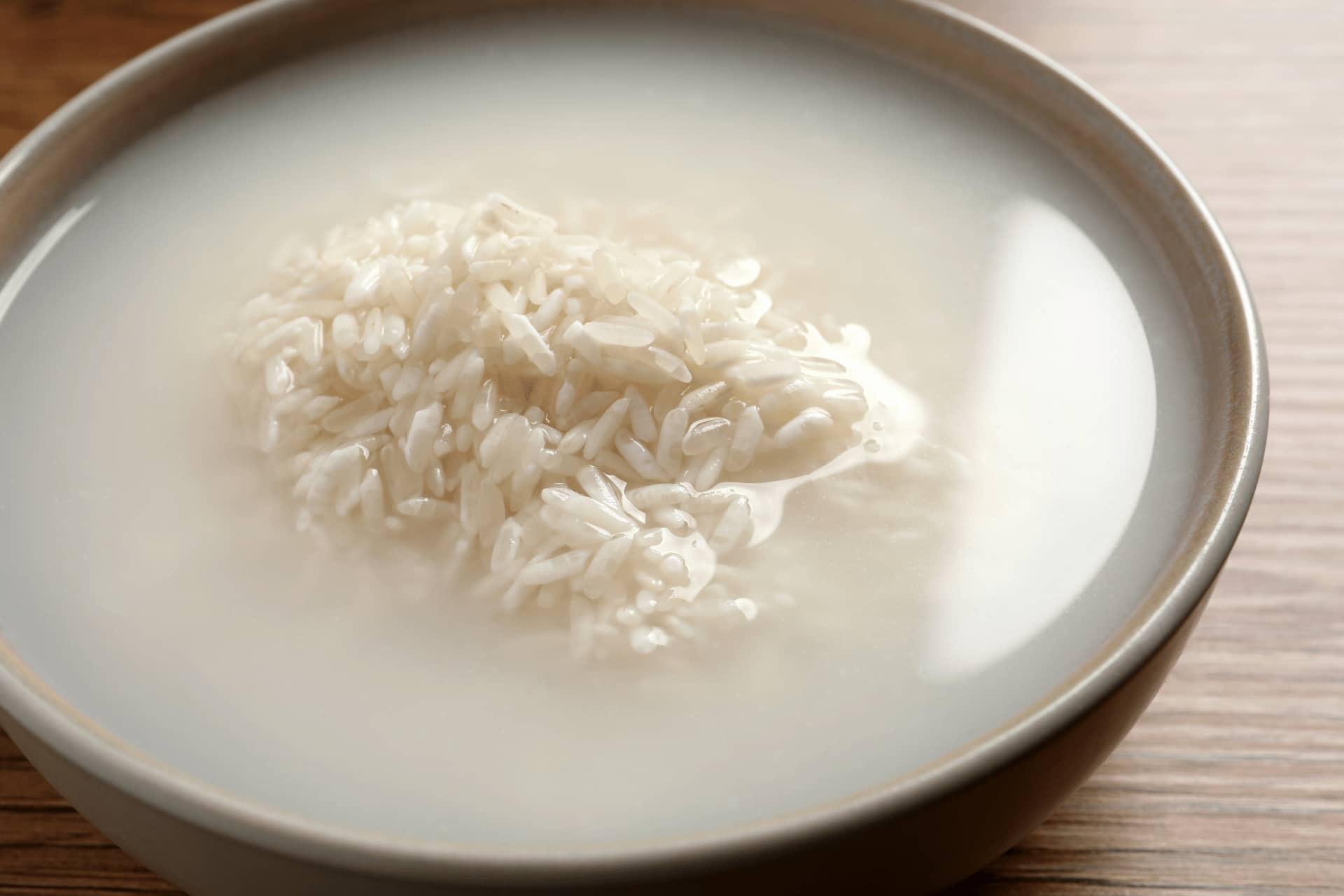
Similarly, maintaining a consistent diet and preventing your cat from eating non-food items can go a long way in preventing diarrhea.
Preventive measures include keeping your cat’s litter box clean, ensuring they’re up to date on vaccinations, and providing them with a balanced diet.
Wet vs. dry Cat Food for Diarrhea
We often get the question: Is wet or dry cat food better for a cat with diarrhea? The answer isn’t a simple yes or no.
Wet cat food is typically high in moisture, which can help keep your cat hydrated – a crucial factor when dealing with diarrhea. Plus, it’s often more palatable, which can tempt a kitty with a decreased appetite to eat. However, wet food can be pricier and has a shorter shelf life once opened.
Dry cat food, on the other hand, is easy to store, has a longer shelf life, and is generally more affordable. Some dry foods are formulated specifically for digestive health, which can help firm up loose stool. However, dry food has less moisture, so make sure your cat is drinking enough water if you choose this option.
At the end of the day, the best food for your cat during a bout of diarrhea depends on their specific needs and preferences. When in doubt, always consult with your vet before making any significant changes to your cat’s diet.
Hydration and Electrolytes for Diarrhea
When a cat has diarrhea, it loses water and electrolytes, the essential minerals that help regulate everything from muscle function to hydration levels. If not adequately replaced, this loss can lead to dehydration and electrolyte imbalance, both of which can have severe consequences.
So, how can you tell if your cat is dehydrated or suffering from an electrolyte imbalance? The signs can be subtle, but some common ones include lethargy, dry gums, loss of appetite, and sunken eyes. In severe cases, your cat may collapse or have a rapid heartbeat. It’s always best to consult your vet if you notice any of these signs.
Rehydrating a cat with diarrhea isn’t as simple as providing more water. Cats with diarrhea may not feel like drinking, and even if they do, their inflamed intestines might not be able to absorb enough water.
One solution is to offer your cat a rehydration solution designed for pets, which contains the right balance of electrolytes. You can also try enticing your cat to drink by offering wet food or making a “broth” from a wet food packet.
It’s important to note that any rehydration solutions, should be used under the guidance of a veterinarian to ensure it’s appropriate for your cat’s specific health situation.
Food Allergens and Intolerances for Diarrhea
In simple terms, a food allergy is an immune system reaction to a specific ingredient, while a food intolerance means your cat has difficulty digesting that ingredient. Both can lead to diarrhea and other digestive issues.
Some of the common food allergens and intolerances in cats include dairy products, fish, beef, and certain grains.
Identifying food allergens and intolerances can be tricky but it’s not impossible. If you suspect that your cat’s diarrhea is due to a particular food, try an elimination diet under the guidance of your vet. This involves removing potential triggers from your cat’s diet and then slowly reintroducing them to see which one causes a reaction.
Alternatively, there are specialized cat foods available that cater to cats with food sensitivities (Hill’s Science Diet Adult Sensitive Stomach & Sensitive Skin Chicken & Rice Recipe Dry Cat Food). These foods are typically free from common allergens and can be a good option if you’re struggling to identify what’s causing your cat’s diarrhea.
Raw, Fresh, or Homemade Cat Food for Diarrhea
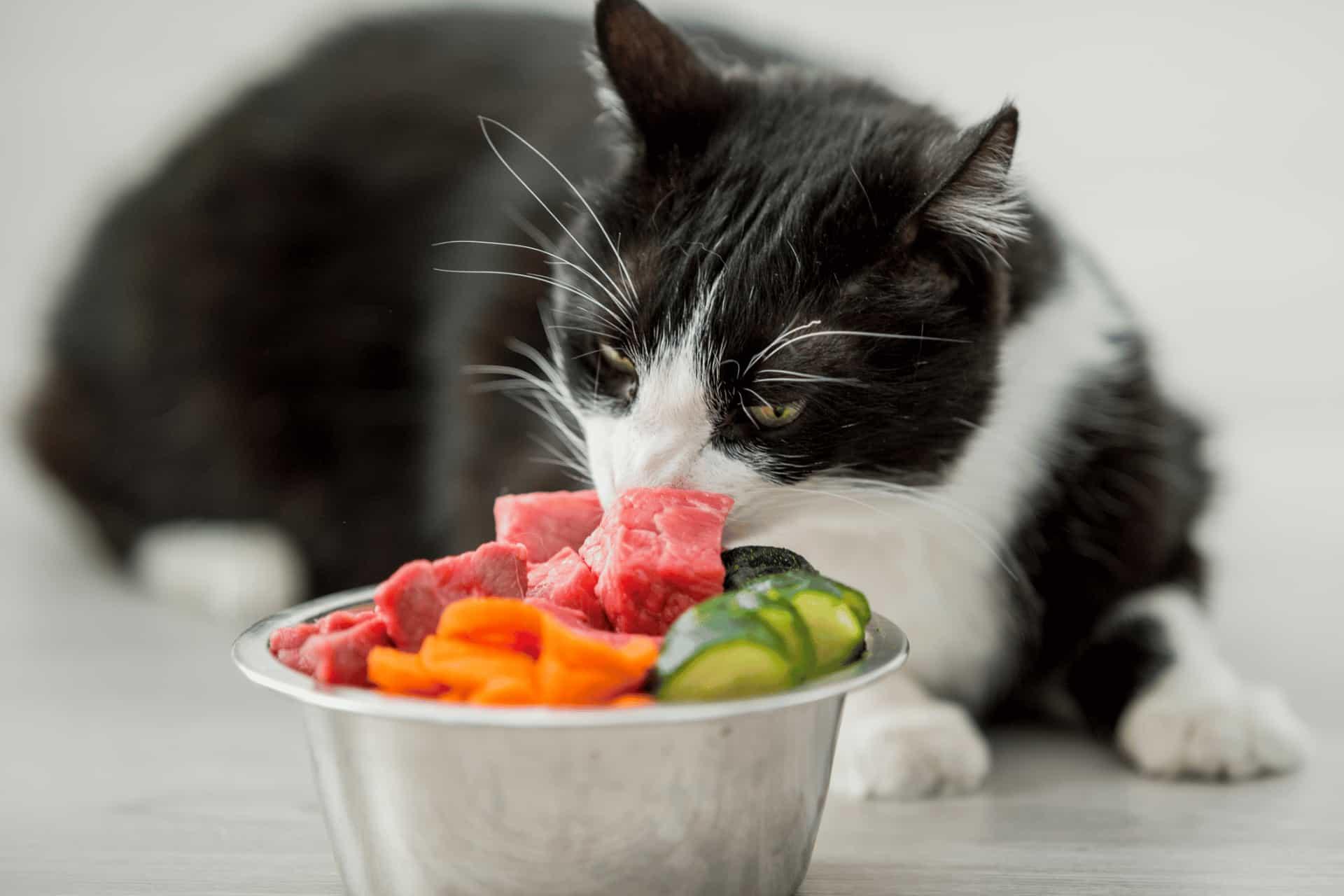
There’s a lot to be said for raw, fresh, or homemade cat food. For one, it can be easier for your cat’s digestive system to process. This is a big plus if your feline friend is struggling with diarrhea. Plus, you can customize the diet to avoid any known allergens or sensitivities.
However, raw diets can carry an increased risk of bacterial contamination. And let’s face it: On top of cat diarrhea, the last thing you want to deal with is a foodborne illness.
If you’ve decided to try raw, fresh, or homemade cat food, remember it’s essential to maintain a balanced diet for your cat. That means not just meat but also the right balance of vitamins, minerals, and other nutrients. Consult a vet or a pet nutritionist to ensure you’re getting it right.
Conclusion
Not generally, but every cat is different. If your cat has a sensitive stomach, it might be best to stick with a gentle dry food option like Hill’s Science Diet Adult Sensitive Stomach & Sensitive Skin Chicken & Rice Recipe Dry Cat Food. This cat food is specially formulated for cats with sensitive stomachs and has proven to be effective in managing diarrhea in many cases.
Choosing the right food for your cat can make a world of difference when dealing with diarrhea. By being informed and making wise choices, you can help your furry friend live a healthier, happier life. Now, isn’t that what being a cat parent is all about?
Frequently Asked Questions
Is Cat Diarrhea an Emergency?
While it can be distressing, cat diarrhea isn’t always an emergency. However, if it’s persistent or accompanied by other symptoms such as vomiting, lethargy, or loss of appetite, it’s time to call the vet.
What Foods Should Cats with Diarrhea Avoid?
Cats with diarrhea should avoid dairy, as many are lactose intolerant. They should also avoid food that’s heavy on artificial ingredients and fillers.
What is the Best Food to Feed a Cat with Diarrhea?
When it comes to finding the best food for cats dealing with diarrhea, a simple, bland diet is often the best route. Look for easily digestible formulas with fewer ingredients.
What Can I Give My Cat to Firm Up His Stools?
To help firm up your cat’s stools, you can give them a diet rich in fiber or probiotic supplements, which have been shown to benefit gastrointestinal health.
Is Wet Food or Dry Food Better for Cats with Diarrhea?
Both can be good options, depending on your cat. Wet food can be easier to digest, while dry food, like our top pick, can help add bulk to their stools.
Does Wet Cat Food Give Cats Diarrhea?
While wet food is generally easier on the stomach, it may not suit all cats. Some cats might experience diarrhea from a sudden change in diet or if they consume a brand that doesn’t agree with them. This doesn’t mean that all wet food will cause diarrhea. If your cat does react negatively to a specific brand, try switching to another.
